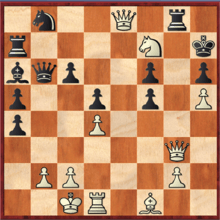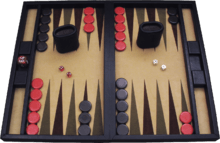Perfect information

In economics, perfect information is a feature of perfect competition. With perfect information in a market, all consumers and producers have perfect and instantaneous knowledge of all market prices, their own utility, and own cost functions.
In game theory, a sequential game has perfect information if each player, when making any decision, is perfectly informed of all the events that have previously occurred, including the "initialization event" of the game (e.g. the starting hands of each player in a card game).[1][2][3][4]
Examples


Chess is an example of a game with perfect information as each player can see all of the pieces on the board at all times.[2] Other examples of games with perfect information include tic-tac-toe, checkers, infinite chess, and Go.[3]
Card games where each player's cards are hidden from other players such as poker and bridge are examples of games with imperfect information.[5][6]
Academic literature has not produced consensus on a standard definition of perfect information which defines whether games with chance, but no secret information, and games with simultaneous moves are games of perfect information.[7][8][9][10][4]
Games which are sequential (players alternate in moving) and which have chance events (with known probabilities to all players) but no secret information, are sometimes considered games of perfect information. This includes games such as backgammon and Monopoly. But there are some academic papers which do not regard such games as games of perfect information because the results of chance themselves are unknown prior to them occurring.[7][8][9][10][4]
Games with simultaneous moves are generally not considered games of perfect information. This is because each of the players holds information which is secret, and must play a move without knowing the opponent's secret information. Nevertheless, some such games are symmetrical, and fair. An example of a game in this category includes rock–paper–scissors.[7][8][9][10][4]
See also
References
- ↑ Osborne, M. J.; Rubinstein, A. (1994). "Chapter 6: Extensive Games with Perfect Information". A Course in Game Theory. Cambridge M.A.: The MIT Press. ISBN 0-262-65040-1.
- 1 2 https://www.math.uni-hamburg/Infinite Games, Yurii Khomskii (2010) Infinite Games (section 1.1), Yurii Khomskii (2010)
- 1 2 "Infinite Chess, PBS Infinite Series" PBS Infinite Series. Perfect information defined at 0:25, with academic sources https://arxiv.org/abs/1302.4377 and https://arxiv.org/abs/1510.08155.
- 1 2 3 4 https://pdfs.semanticscholar.org Games with Perfect Information (Mycielski).
- ↑ Thomas, L. C. (2003). Games, Theory and Applications. Mineola N.Y.: Dover Publications. p. 19. ISBN 0-486-43237-8.
- ↑ Osborne, M. J.; Rubinstein, A. (1994). "Chapter 11: Extensive Games with Imperfect Information". A Course in Game Theory. Cambridge M.A.: The MIT Press. ISBN 0-262-65040-1.
- 1 2 3 https://cs.stanford.edu Game Theory: Rock, Paper, Scissors (Chen, Su-I Lu, Vekhter).
- 1 2 3 https://www.math.ucla.edu Game Theory (Ferguson).
- 1 2 3 https://www.aaai.org Solving Imperfect Information Games Using Decomposition (Burch, Johanson, Bowling).
- 1 2 3 https://math.stackexchange.com Complete vs Perfect information in Combinatorial game theory.
Further reading
- Fudenberg, D. and Tirole, J. (1993) Game Theory, MIT Press. (see Chapter 3, sect 2.2)
- Gibbons, R. (1992) A primer in game theory, Harvester-Wheatsheaf. (see Chapter 2)
- Luce, R.D. and Raiffa, H. (1957) Games and Decisions: Introduction and Critical Survey, Wiley & Sons (see Chapter 3, section 2)
- The Economics of Groundhog Day by economist D.W. MacKenzie, using the 1993 film Groundhog Day to argue that perfect information, and therefore perfect competition, is impossible.